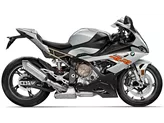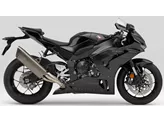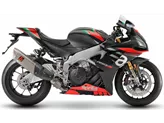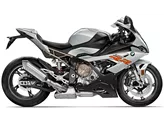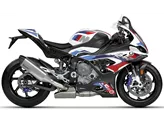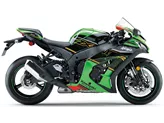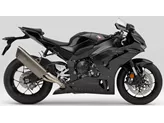BMW S 1000 RR 2017 vs. Suzuki GSX-R 1000 R 2017

BMW S 1000 RR 2017

Suzuki GSX-R 1000 R 2017
Vue d’ensemble - BMW S 1000 RR 2017 vs Suzuki GSX-R 1000 R 2017
The BMW S 1000 RR 2017 and the Suzuki GSX-R 1000 R 2017 are both powerful supersport motorcycles with similar engine specifications. Both bikes have an in-line, 4-cylinder engine with a displacement of 999cc. The BMW S 1000 RR produces 199 HP of power and 113 Nm of torque, while the Suzuki GSX-R 1000 R produces slightly more power at 202 HP and 118 Nm of torque. Both bikes have a high compression ratio of 13 and 13.2 respectively, indicating their high-performance capabilities.
In terms of suspension, both bikes feature upside-down telescopic forks at the front and swing arm suspension at the rear. The chassis of both bikes is made of aluminum, providing a lightweight yet sturdy frame. The BMW S 1000 RR has a twin-tube frame, while the Suzuki GSX-R 1000 R has a twin-tube, twin-spar frame. Both bikes have double disk brakes at the front, but the Suzuki GSX-R 1000 R has the additional feature of monoblock technology in its braking system, enhancing its braking performance.
In terms of dimensions and weights, both bikes have a front tire width of 120 mm and a rear tire width of 190 mm, with a 17-inch diameter for both tires. The wheelbase of the BMW S 1000 RR is slightly longer at 1438 mm compared to the Suzuki GSX-R 1000 R's 1410 mm. The seat height of the BMW S 1000 RR is 815 mm, while the Suzuki GSX-R 1000 R has a slightly higher seat height of 825 mm. The kerb weight of the BMW S 1000 RR with ABS is 208 kg, slightly heavier than the Suzuki GSX-R 1000 R's 203 kg. Both bikes have a fuel tank capacity of 17.5 liters.

BMW S 1000 RR 2017
Now let's compare the strengths and weaknesses of each bike. The BMW S 1000 RR has the advantage of being available with complete electronic equipment, allowing riders to have access to advanced features. The bike also has a strong engine that is powerful and easy to control, making it suitable for both experienced and novice riders. Additionally, the BMW S 1000 RR offers a comfortable seating position, even for taller riders. The bike also boasts a good chassis, providing stability on both the road and track.
On the other hand, the Suzuki GSX-R 1000 R has a high-revving engine with a smooth torque curve, ensuring a thrilling riding experience. The bike is particularly stable on corner exit and radius, making it ideal for riders who enjoy fast-paced riding. The Suzuki GSX-R 1000 R also features a great quickshifter and a high-quality chassis, further enhancing its performance on the track.

Suzuki GSX-R 1000 R 2017
However, the BMW S 1000 RR does have some weaknesses. It may experience brake fade on the racetrack under high load, which can be a disadvantage for riders who frequently engage in high-speed riding. While the ride quality of the BMW S 1000 RR is sufficient for trackdays, it may not be up to par for racing. Additionally, some riders may find the appearance of the BMW S 1000 RR to be dull or outdated, despite its advanced technical features.
Similarly, the Suzuki GSX-R 1000 R also has a few weaknesses. The engine brake of the bike is not adjustable, which may limit the customization options for riders who prefer a specific braking feel. Additionally, the wheely control of the Suzuki GSX-R 1000 R is linked to the traction control system, which may restrict the rider's ability to fine-tune their riding experience.
In conclusion, both the BMW S 1000 RR 2017 and the Suzuki GSX-R 1000 R 2017 are powerful and capable supersport motorcycles. While the BMW S 1000 RR offers a complete electronic package and a comfortable seating position, the Suzuki GSX-R 1000 R excels in high-revving performance and stability on the track. However, both bikes have their weaknesses, such as brake fade for the BMW S 1000 RR and limited adjustability for the engine brake of the Suzuki GSX-R 1000 R. Ultimately, the choice between these two bikes will depend on the rider's preferences and priorities.
Caractéristiques techniques BMW S 1000 RR 2017 par rapport à Suzuki GSX-R 1000 R 2017
Avantages et inconvénients en comparaison
Avantages et inconvénients en comparaison
BMW S 1000 RR 2017

Ce talent universel et équilibré restera en tête de nombreux tests comparatifs en 2017. Elle marque toujours des points grâce à son moteur exceptionnel et à ses caractéristiques universelles et complètes.
Suzuki GSX-R 1000 R 2017

Suzuki a réussi à rendre la GSX-R 1000 R 2017 géniale. Une moto puissante comme un ours avec une courbe de couple incroyablement douce. Incroyable avec 202 ch ! Le châssis est de grande qualité et l'électronique n'a pas de paillettes, mais elle offre des performances exceptionnelles.
Comparaison des prix Prix moyen du marché BMW S 1000 RR vs Suzuki GSX-R 1000 R
There are a few key differences between a BMW S 1000 RR 2017 and a Suzuki GSX-R 1000 R 2017. There are the same number of bikes of both models available on the 1000PS.de marketplace, specifically 9. It takes less time to sell a BMW S 1000 RR with 96 days compared to 176 days for a Suzuki GSX-R 1000 R. Since model year 2010 1000PS.de editors have written 135 reviews for the BMW S 1000 RR and 13 reviews for the Suzuki GSX-R 1000 R since model year 2017. The first review for the BMW S 1000 RR was published on 4/16/2008 and now has more than 4,000 views. This compares to more than 197,700 views for the first review on Suzuki GSX-R 1000 R published on 10/4/2016.



